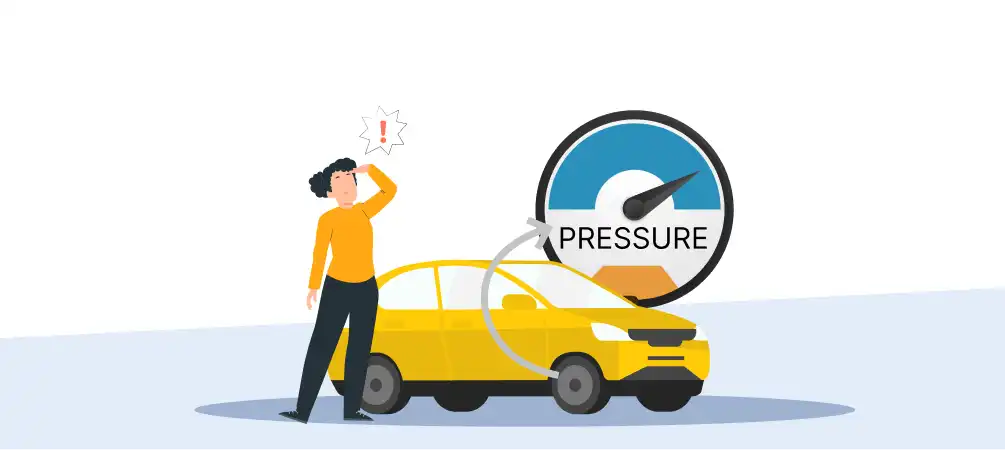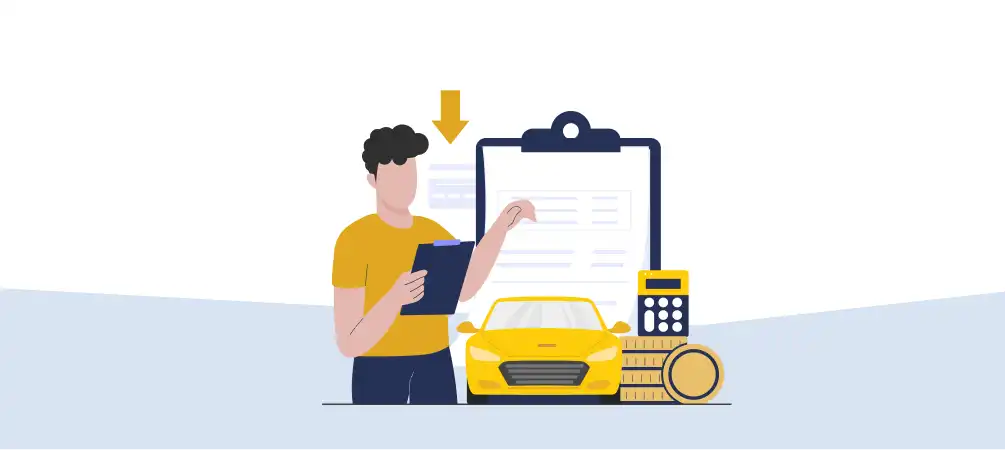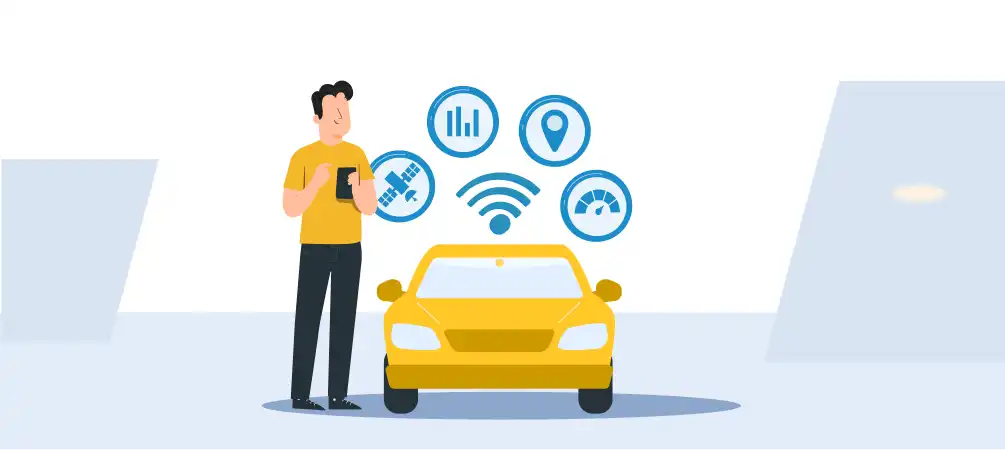Car Tyre Pressure Monitoring: Why It Matters and How to Check
Monitoring car tyre pressure is crucial for every four-wheeler because it ensures safe driving, better fuel efficiency, and long tyre life. Unfortunately, many drivers don’t understand its relevance until they encounter a problem.
Ignoring car tyre pressures may lead to overinflated or underinflated tyres. In this blog, we’ve covered the importance of tyre pressure monitoring, steps to measure tyre pressure, etc., so you can prevent tyre-related challenges.

Table of Contents
Why Tyre Pressure Monitoring Matters
Car tyre pressure monitoring refers to tracking a vehicle’s tyre pressure levels. It can be done using an advanced Tyre Pressure Monitoring System (TPMS) or a manual check. Every car owner should monitor their vehicle’s tyre pressure because it prevents them from overinflating or underinflating.
If your tyre have underinflation, it can increase rolling resistance and may raise the risk of blowouts. On the other hand, tyres with excessive air pressure can decrease road grip and even cause uneven wear. Regular tyre pressure monitoring will help you maintain your car tyre’s optimal performance levels.
Types of Tyre Pressure Monitoring Systems (TPMS)
Direct TPMS
Direct Tyre Pressure Monitoring System (TPMS) operates by using pressure sensors installed inside vehicle tyres to measure air pressure in real-time. The installed sensors send data to the car’s internal computer, which is displayed on your dashboard.
You get display alerts on the dashboard if your car’s tyre pressure drops below or rises above the recommended levels. This system is highly accurate and reliable.
Indirect TPMS
Indirect Tyre Pressure Monitoring System (TPMS) works by using the car’s anti-lock braking system (ABS) wheel speed sensors for detecting changes in the tyre’s air pressure.
When a car’s tyre is underinflated, it will rotate faster than optimally inflated tyres. Indirect TPMS detects this irregularity and alerts the driver. While it’s cheaper than direct TPMS, it’s also less accurate because it estimates tyre pressure indirectly.
How to Check Tyre Pressure?
If you want to manually check your car’s tyre pressure, start by parking your car on a flat surface and letting the tyres cool down. In the meantime, check the recommended PSI. You can find it on the driver’s door sticker or in the car manual.
Once done, follow these steps given below:
- Remove the tyre’s valve cap and attach a tyre pressure gauge to the valve stem
- Wait for a few seconds and then read the pressure displayed on the gauge
- Add air (if underinflated) and release air gently (if overinflated) until PSI matches the recommended levels.
- Place the valve cap on the tyre and repeat the same for the remaining tyres
Common Mistakes and Myths
Nitrogen vs. Air
If you think nitrogen is better for car tyres than regular air and vice versa, then you should understand that neither is superior to the other, as both have their pros and cons. You can choose nitrogen for its ability to maintain pressure longer than regular air and reduce moisture inside tyres. However, it isn’t as accessible as regular air for car tyres.
On the contrary, regular air is easily available and works well for most drivers. Since the performance difference between nitrogen and regular air is minor for everyday cars, you can choose whichever is easily available and aligns with your budget.
Ignoring TPMS Alerts or Relying Solely on Them
One of the biggest mistakes some drivers make is either ignoring or relying entirely on Tyre Pressure Monitoring System (TPMS) alerts. Both are risky. While TPMS is helpful, it isn’t a substitute for manual checks.
Drivers should not ignore TPMS alerts, as it may lead to road accidents. Also, over-relying may cause drivers to miss gradual air leaks or faulty sensor readings. Hence, use your car’s TPMS alerts for guidance, but also invest in frequent manual checks for safety and smooth car performance.
Why Tyre Maintenance Matters for Insurance?
Insurance Claims are Affected
Whether you have comprehensive or third-party insurance, claim settlement will be affected by your car’s tyre maintenance. If a road accident occurs due to negligence, like driving with dangerously underinflated tyres, insurers may partially or fully reject your insurance claims, citing poor vehicle upkeep.
Impacts Premiums
Having a functional Tyre Pressure Monitoring System (TPMS) can create a positive impression on insurers because it signals proactive safety measures. It may help you get faster claim settlements or secure lower premiums.
Conclusion
Tyre pressure monitoring isn’t just another technical feature but a fundamental part of road safety and vehicle care. Every vehicle owner should routinely check their car’s tyre pressure, either through TPMS or manual checks, for safety and proper vehicle maintenance. If the pressure drops or rises below the ideal levels, follow the corrective measures discussed in this blog.
You should also secure your car under comprehensive car insurance to financially protect yourself and the vehicle in case of damage due to poor tyre upkeep or road accidents.
You can choose Comprehensive Car Insurance provided by Shriram General Insurance, as we provide enhanced coverage at affordable premiums. We also provide a wide range of add-on covers, such as Roadside Assistance Cover, Zero Depreciation Cover, etc., for seamless coverage upgrades.
FAQs
What is TPMS, and how does it work?
TPMS is a system that monitors tyre pressure in real-time using sensors installed inside the tyres. It alerts drivers about pressure drops or overinflation to prompt instant corrective measures.
Can I install TPMS in any car?
Yes, you can install TPMS in any car. There are numerous aftermarket TPMS kits, which are compatible with most car designs.
How often should I manually check my tyre pressure?
Manual tyre pressure checks should be done at least once a week or right before any long trip, even if your car has TPMS.
Is nitrogen better than air for tyres?
Neither is better than the other, as both have pros and cons.
What PSI is ideal for Indian cars?
The ideal PSI is between 32-35 PSI/cold for most Indian hatchbacks and mid-size sedans.
What happens if I ignore TPMS warnings?
If you ignore TPMS warnings, then you may encounter tyre blowouts, poor handling, reduced mileage, and increased accident risks.
Are aftermarket TPMS reliable?
Yes, most aftermarket TPMS are reliable. Just ensure you choose a good-quality aftermarket TPMS kit and install it properly for best results.
How do I know if my car has TPMS?
Most modern cars come equipped with TPMS as a standard vehicle feature. You can check your car’s manual to confirm if your car has TPMS.
Can TPMS help prevent tyre blowouts?
Yes, TPMS can help prevent tyre blowouts by alerting the driver about abnormal air pressure in tyres.
What tools do I need to check tyre pressure?
A digital or manual tyre pressure gauge and an air compressor are essential tools for checking tyre pressure.



 31
31


















